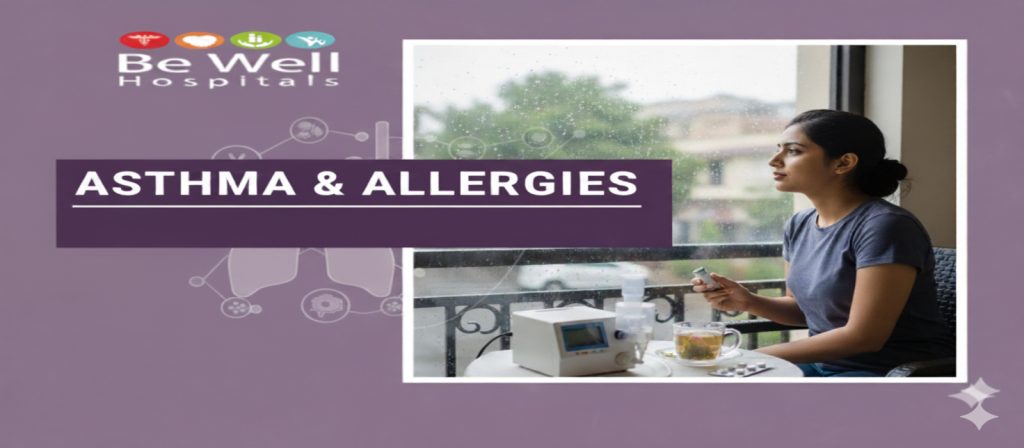
Introduction
As the seasons change, those living with asthma and allergies often face heightened challenges. Shifts in temperature, humidity, and pollen levels can trigger respiratory issues ranging from mild discomfort to severe attacks. Understanding how weather impacts your respiratory health is essential for maintaining wellness year-round. By recognizing early symptoms, identifying triggers, and adopting preventive strategies, individuals can manage their conditions effectively. This guide explores practical tips, treatment options, and lifestyle adjustments to help you breathe easier, stay active, and protect your respiratory health no matter what the weather brings.
What is Asthma?
Asthma is a chronic respiratory condition in which the airways become inflamed, narrow, and produce excess mucus. This leads to symptoms such as wheezing, shortness of breath, chest tightness, and coughing. Triggers can include allergens, respiratory infections, cold air, exercise, or stress. While asthma cannot be completely cured, it can be managed effectively with proper medication, lifestyle adjustments, and trigger avoidance. Regular monitoring and personalized action plans developed with your doctor can prevent severe attacks and allow individuals to live active, healthy lives.
Types of Asthma
- Allergic (Extrinsic) Asthma: Triggered by allergens such as pollen, dust mites, pet dander, or mold. Common in children and often associated with eczema or hay fever.
- Non-Allergic (Intrinsic) Asthma: Caused by stress, exercise, cold air, infections, or irritants like smoke and strong odors. More common in adults.
- Exercise-Induced Asthma (EIA): Symptoms occur during or after physical activity, causing coughing or wheezing. Preventable with pre-exercise inhalers.
- Occupational Asthma: Triggered by workplace irritants or allergens like chemicals, fumes, or dust. Symptoms improve when away from the environment.
- Cough-Variant Asthma: Characterized mainly by a persistent dry cough. Can develop into classic asthma if untreated.
- Severe Asthma: Difficult to control despite standard treatments. Requires specialized care and monitoring.
Common Respiratory Allergies
Respiratory allergies occur when the immune system overreacts to harmless substances, or allergens, affecting the airways. Common triggers include pollen, dust mites, mold, pet dander, and cigarette smoke. Symptoms include sneezing, nasal congestion, runny nose, coughing, wheezing, and shortness of breath. Allergic reactions can worsen asthma or cause sinus infections. Seasonal allergies, like hay fever, appear at specific times of the year, while perennial allergies persist year-round. Identifying triggers, reducing exposure, and using medications such as antihistamines or nasal sprays are key to effective management.
How Asthma and Allergies Are Connected
Asthma and allergies are closely linked, as both involve immune system overreactions. Allergens such as pollen, dust mites, mold, and pet dander can inflame the airways, causing asthma symptoms like wheezing, coughing, and shortness of breath. Many people with asthma also experience allergic conditions like hay fever or eczema. This overlap, known as allergic asthma, means managing allergies can help control asthma flare-ups. Identifying triggers, avoiding allergens, and using appropriate medications such as inhalers or antihistamines are essential for reducing symptoms and preventing severe attacks.
Impact of Weather Changes on Respiratory Health

- Cold Air Exposure: Cold air can constrict airways, triggering coughing, wheezing, or attacks.
- Sudden Temperature Fluctuations: Rapid changes from warm to cold or vice versa stress the respiratory system and worsen symptoms.
- Humidity Levels: High humidity promotes mold and dust mites, while low humidity dries airways—both aggravate respiratory issues.
- Air Pollution: Weather can trap pollutants or increase smog, irritating the lungs and exacerbating asthma and allergies.
- Seasonal Allergens: Pollen levels rise during spring and fall, triggering allergic reactions and asthma flare-ups.
- Thunderstorms and Wind: Storms can spread pollen and mold spores, while strong winds carry allergens long distances.
- Respiratory Infections: Cold and rainy seasons increase the risk of colds, flu, and other infections that worsen asthma.
Signs of Asthma Flare-Ups
- Frequent coughing, especially at night or early morning
- Wheezing or a whistling sound when breathing
- Shortness of breath or difficulty performing mild activities
- Chest tightness or pressure
- Rapid or labored breathing
- Trouble sleeping due to nighttime symptoms
- Fatigue from the extra effort of breathing
- Difficulty speaking in severe cases
Common Allergy Symptoms
- Frequent sneezing
- Runny or congested nose
- Itchy, watery, or red eyes
- Persistent cough or throat irritation
- Wheezing or shortness of breath in sensitive individuals
- Skin reactions like rashes, hives, or eczema flare-ups
- Fatigue or irritability due to constant allergen exposure
- Headaches or sinus pressure from congestion
Preventive Strategies for Managing Asthma and Allergies
- Avoid Environmental Triggers: Identify and minimize exposure to allergens like pollen, dust, mold, pet dander, smoke, and strong odors. Keep windows closed during high-pollen seasons, wear masks outdoors if needed, and avoid exercising during peak pollen hours.
- Indoor Air Quality Management: Use exhaust fans, control humidity between 40–50%, clean heating/cooling systems, and regularly wash bedding and curtains in hot water to reduce dust mites and mold.
- Air Purifiers and Dust Control: HEPA filters trap fine particles, pollen, and pet dander. Vacuum frequently with HEPA vacuums, dust with damp cloths, and consider allergen-proof covers for mattresses and pillows.
Medication and Treatment Options
- Inhalers: Short-acting relievers for immediate relief and long-acting controllers with corticosteroids for daily prevention.
- Oral Medications: Antihistamines, leukotriene modifiers, and decongestants for allergy or asthma symptom relief.
- Nasal Sprays: Corticosteroid sprays reduce nasal inflammation; saline sprays clear allergens and maintain moisture.
- Allergy Immunotherapy: Shots or sublingual tablets gradually desensitize the immune system to specific allergens.
- Emergency Treatments: Epinephrine auto-injectors for severe allergic reactions; oxygen therapy, nebulizers, or IV medications for severe asthma attacks.
- Monitoring Devices: Peak flow meters and digital apps track lung function, detect early signs of exacerbation, and monitor medication usage.
Lifestyle and Home Remedies
Managing asthma and allergies goes beyond medication. Maintaining a clean home, avoiding smoking and strong odors, and controlling indoor humidity are crucial. Regular moderate exercise such as walking, yoga, or swimming strengthens lungs, while breathing exercises improve airflow and reduce stress. A balanced diet rich in fruits, vegetables, and omega-3 fatty acids supports immunity and reduces inflammation. Staying hydrated thins mucus, easing breathing. Wearing masks during high-pollen seasons, using air purifiers, and monitoring air quality alerts help prevent flare-ups outdoors.
Conclusion
Asthma and allergies can be challenging, especially during seasonal or weather changes, but with awareness, prevention, and timely treatment, they can be effectively managed. Recognizing triggers, maintaining clean indoor air, following prescribed medications, and adopting healthy lifestyle adjustments all support better respiratory function. Regular monitoring and professional guidance help minimize flare-ups and improve overall quality of life. By taking proactive steps, individuals with asthma and allergies can live with confidence, comfort, and ease, regardless of the weather.
For expert advice and personalized care, visit Be Well Hospitals Pulmonology Department or call 9698 300 300 to book appointments and take charge of your respiratory health.
